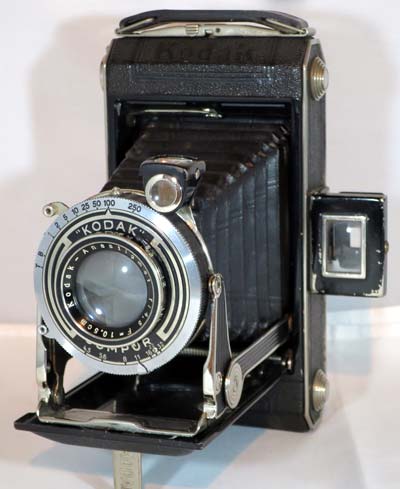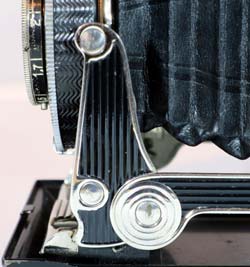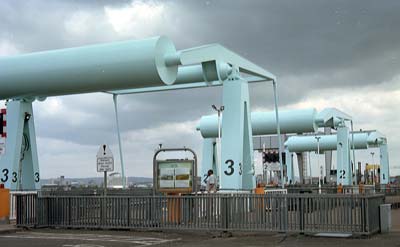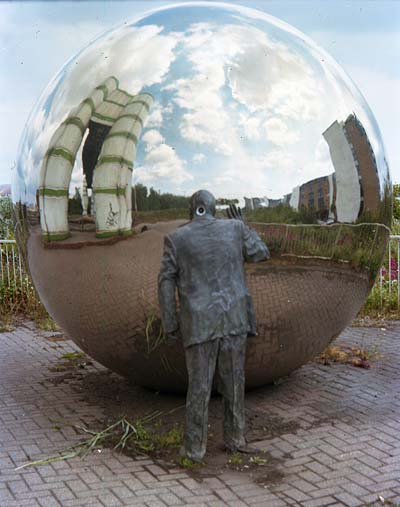Kodak Vollenda 620
Specification

| Manufacturer | : | Kodak |
|---|---|---|
| Produced | : | UK 1936 - 1939 |
| Classification | : | Medium Format |
| Body Type | : | Folding Bed |
| Bellows Deployment | : | Self Erecting |
| Construction | : | Metal |
| Film Type | : | 620 |
| Film Width | : | 62mm |
| ImageSize | : | 2¼ x 3¼ in |
| No. of Images | : | 8 |
| Lens Type | : | Kodak Anastigmat |
| Focal Length | : | 105mm |
| Focus Type | : | Variable |
| Focal Range | : | 1.5m - inf. |
| Aperture Type | : | Iris |
| Aperture | : | f/4.5 - f/32 |
| Shutter Type | : | Compur |
| Shutter Speeds | : | T,B, I(1/250 - 1 sec) |
| Size Closed (w x h x d) | : | 95 x 185 x 39 mm |
| Size Open (w x h x d) | : | 125 x 185 x 145 mm | Weight | : | 620g |
Art Deco Credentials
![]()
![]()
![]()
![]()
Significant: Pronounced and self evident
- Produced during the main Art Deco period.
- Geometric black and chrome faceplate design.
- Black & chrome struts with vertical and horizontal embossed pattern.
- Angled ends to body.
- Chrome edging to body.
- Bellows embossed with lines.
- Body leatherette embossed with linear pattern.
- Wavey design on shutter body.
- Concentric stepped circles on spool centres.
- Concentric stepped circles on front door release.
- Chrome winder, tripod boss and film door latch.
- Chrome line embossed base plate latch.
- Black & chrome pop-up finder
Description

The Vollenda 620 is a self erecting folding rollfilm camera that takes 8, 2½ x 3¼ inch exposures on 620 rollfilm. It has a f/4.5, 105 mm Kodak Anastigmat lens. The iris diaphragm gives a range of f/4.5 to f/32. It has a variable focus and will focus down to 3 feet. It has a rim-set Compur shutter with speeds 1 - 1/250s, B, T. It has a delayed action setting giving a delay of about 10-12 seconds.
The metal body is covered in leather and it has leather bellows. It has both a brilliant finder on the lens plate and a direct optical finder on the body. Film advance is indicated by red window and is not coupled to shutter so double exposure is possible. The first version of this camera appeared in 1934 but it had nickel trim rather than chrome and a frame finder rather than the optical finder.
Several lens and shutter combinations were available. These were:-
- Kodak Anastigmat f/4.5: 1934 - 1939: Compur S shutter.
- Kodak Kodar Anastigmat f/4.5: 1935-1936 : Kodak 4s S or 8S shutter; Compur shutter
- Kodak Kodar Anastigmat f/6.3: 1935-1936 : Kodak shutter.
- Schneider Xenar f/3.5 or f/4.5: 1935-1936 : Compur shutter. 1936-1939 : Compur S shutter.
- Zeiss Tessar f/4.5: 1936-1939 : Compur S shutter.
How to Use
Find the camera manual here
This camera takes 620 film which is still available from selected photographic outlets. Although the actual film is the same as 120 film, the spools are different. The 620 spools are slightly shorter and have a smaller diameter. Do not use 120 film in this camera because it will jam and may snap. It is possible to cut down a spool of 120 film to fit or to re-spool some 120 film onto 620 spools in a darkroom or changing bag.
If you don't want to bother with an exposure meter, follow the guide shown, using shutter speeds are 1/25s, 1/50s and 1/100s only. It is based on the 'Sunny 16' rule. Film is so forgiving and will produce acceptable results even when overexposed by 2 or 3 stops or underexposed by 1 stop.Remember that the exposure guide in the camera user manual may not be helpful as it is based on the use of old film with a low ISO value.
The tables assume that the sun is at least 30 degrees above the horizon - that's 10am - 5pm on a summer's day (May-August) in the UK.
If you are not sure about the light level, err on the side of overexposure - i.e. assume the smaller f number.
Where there is a choice, a larger f number will give a larger depth of field.
For the slower speeds, you may need a tripod to stop blur through shake.
Using ISO 100/125 film
| Weather Conditions | Shadow Detail | Shutter Speed (s) | ||
|---|---|---|---|---|
| 1/25 | 1/50 | 1/100 | ||
 Sunny SunnySnow/Sand | Dark with sharp edges | - | f/32 | f/22 |
 Sunny Sunny | Distinct | f/32 | f/22 | f/16 |
 Slight Overcast Slight Overcast | Soft around edges | f/22 | f/16 | f/11 |
 Overcast Overcast | Barely visible | f/16 | f/11 | f/8 |
 Heavy Overcast Heavy Overcast | None | f/11 | f/8 | f/5.6 |
 Open Shade Open Shade/Sunset | None | f/8 | f/5.6 | f/4.5 |
Photographs taken with this Camera
Kodak Portra 160 film. Developed in Tetenal.



